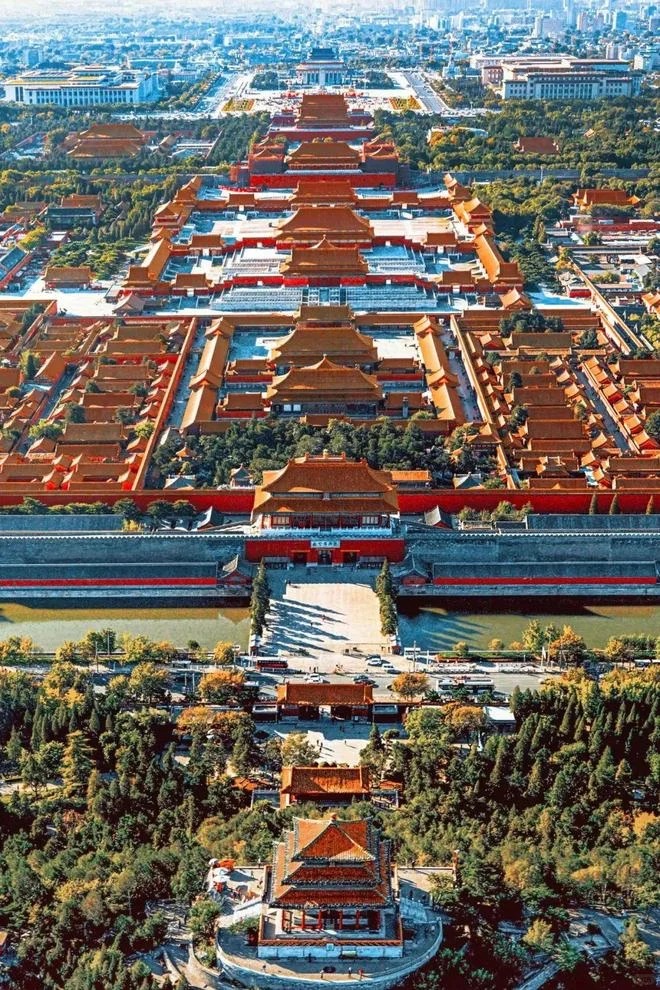Great Wall hiking in Beijing offers a once-in-a-lifetime experience, combining scenic views, rich history, and the thrill of walking one of the world’s most iconic structures. Whether you're hiking the Great Wall for the first time or returning for a new route, the Wall offers a rich variety of landscapes — from fully restored paths like Mutianyu to rugged wilderness sections like Jiankou, perfect for adventurers of all levels. Whether you're an experienced trekker or planning your very first Great Wall hike, this complete guide covers the best sections, practical tips, safety advice, and essential planning details for an unforgettable journey.
When I first decided to start hiking the Great Wall, I imagined easy paved trails and postcard-perfect views at every turn. But the reality was far richer and more complex — steep stone stairways climbing along sharp ridgelines, sections overgrown with wild grass and shrubs, long stretches where I walked alone beneath ancient watchtowers, and the constant need to assess my fitness, weather conditions, and hiking routes. The Wall revealed itself not as a single destination, but as many diverse experiences layered together along its vast length.
In this Great Wall hiking guide, I’ll share everything I’ve learned — from how to select the right section for your skill level, to when to visit for the best conditions, to often-overlooked planning details that can make or break your Great Wall trekking adventure.
Which Great Wall Sections Are Best for Hiking?
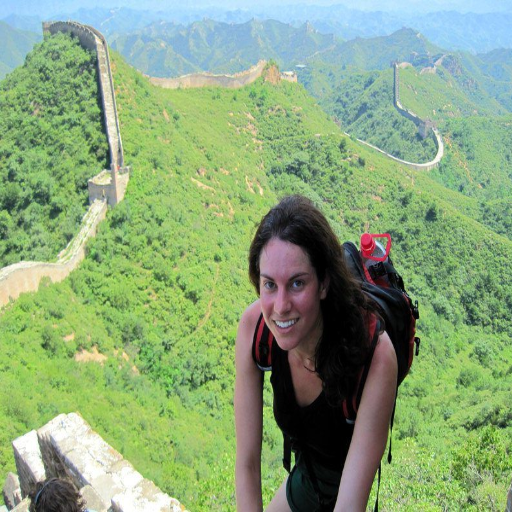
How to Get to Jiankou: Step-by-Step from Beijing
Reaching Jiankou may seem remote, but it’s very doable with the right planning.
By Public Transport: From Beijing’s Dongzhimen station, take the 916 Express Bus to Huairou North Avenue (怀柔北大街). Then, catch a local H25 bus to Xizhazi Village — though this bus runs infrequently, and a walk or local transfer may still be needed.
By Private Transfer: Hiring a car or arranging a guesthouse shuttle is the easiest option, especially if you're carrying gear or camping overnight. The journey usually takes around 2 to 2.5 hours from central Beijing.
Quick Tips Before You Go:
Start early to ensure daylight for the full hike
Download offline maps (like Maps.me or Gaia GPS)
Know essential destinations in Chinese to assist communication
Jiankou: The Wild Great Wall
If you’re looking for raw, untamed beauty, Jiankou is where you’ll find it. The hike starts from Xizhazi Village, a quiet settlement tucked deep in the mountains. From there, a steep forest trail leads to the crumbling wall. I still remember my first climb here: narrow footpaths carved into ridgelines, the wind rushing through shattered watchtowers, and that surreal moment when the forest gave way to open sky and ancient stone.
Jiankou is notorious for its technical challenge — wild, unrestored, and thrillingly unpredictable. Its name—“Arrow Nock”—reflects the sharp curvature of its ridgeline, which looks like an arrow ready to launch.
Highlights:
Steep limestone cliffs with jaw-dropping drops
Notable towers like “The Eagle Flies Facing Upward” and “Zhengbei Tower”
Stunning sunrise and sunset vantage points
Remote atmosphere and near-total solitude
Sky Stairs: a near-vertical climb that tests nerves and stamina
Quick Facts:
- Distance from Beijing: ~70 km
- Difficulty: Hard
- Best For: Experienced hikers
- Access: Xizhazi Village trailhead (private transfer recommended)
Mutianyu: Beauty with Comfort
If Jiankou is wild, Mutianyu offers one of the most accessible Great Wall of China hiking sections, with fully restored pathways providing both safety and sweeping panoramic views, making it one of the best options for families and first-time visitors. What makes Mutianyu special is that it still retains its majesty while avoiding the heavy crowds seen at Badaling. Mutianyu remains one of the most accessible and scenic Great Wall hiking routes near Beijing — ideal for families, seniors, and photographers seeking a rewarding experience.
Highlights:
22 fully restored watchtowers that showcase classic Ming Dynasty architecture in pristine condition.
Lush forested surroundings that shift beautifully with each season—cherry blossoms in spring, vibrant greenery in summer, brilliant foliage in autumn, and snow-capped towers in winter.
Cable cars, chairlifts, and a toboggan slide offering both accessibility and fun alternative descents for visitors of all ages.
Well-maintained stone pathways with sturdy guardrails, making it safe for children, seniors, and casual walkers.
Modern visitor facilities, including clean restrooms, food stalls, souvenir shops, and convenient transportation access.
Close proximity to Beijing allows for easy half-day or full-day trips without complicated logistics.
Quick Facts:
- Distance from Beijing: ~70 km
- Difficulty: Easy–Moderate
- Best For: Families, seniors, photography lovers
Jinshanling: The Balanced Route
When hikers ask me for “something in between,” I almost always suggest Jinshanling. The section offers a balanced mix of restored and original wall segments, allowing visitors to experience both architectural integrity and a sense of wilderness.
Highlights:
A 10-kilometer route combining both well-preserved sections and original unrestored ruins, providing the perfect contrast of restoration and authenticity.
Over 30 distinctive watchtowers, many still featuring original bricks, decorative crenellations, and intricate defensive features.
Gently rolling hills and broad mountain views that stretch endlessly, particularly stunning during sunrise and sunset hikes.
Fewer tourists even during peak season, allowing for quieter, more immersive walks.
Mild elevation changes compared to Jiankou but still challenging enough to satisfy serious hikers.
Exceptional photo opportunities along ridge paths where the Wall seems to snake across the horizon like a dragon's spine.
Quick Facts:
- Distance from Beijing: ~130 km
- Difficulty: Moderate–Hard
- Best For: Hikers wanting a balanced challenge
Gubeikou: Untouched History & Quiet Solitude
Highlights:
One of the most historically preserved sections, with original Ming Dynasty watchtowers still standing in semi-ruined yet authentic condition.
Crumbling stone walls and broken parapets that offer hikers a glimpse into the raw, unfiltered state of the Wall as it stood centuries ago.
Remote location with minimal tourist infrastructure, allowing for a peaceful, crowd-free hiking experience.
Sweeping valley views framed by rolling hills and distant mountain ridgelines, especially beautiful in early morning or late afternoon light.
Ideal for hikers seeking a slower pace, rich historical atmosphere, and opportunities for quiet reflection.
Easier terrain compared to Jiankou, making it suitable for moderately fit hikers looking for a more authentic, non-commercialized Wall experience.
Quick Facts:
Distance from Beijing: ~140 km
Difficulty: Moderate
Best For: History lovers and hikers preferring authentic, peaceful routes
Simatai: Night Views & Dramatic Landscapes
Highlights:
The only officially sanctioned section for night hikes, where the Wall glows under floodlights and the surrounding mountains are silhouetted by moonlight.
Features 16 distinct watchtowers, each perched along steep ridgelines offering panoramic 360-degree views even during daylight hikes.
Partially restored pathways make the climb challenging but accessible for visitors seeking both adventure and safety.
Proximity to Gubei Water Town allows for convenient accommodation, dining, and cultural immersion, making it a perfect overnight destination.
Famous for sunrise and sunset photography, capturing the Wall draped in soft light across the rugged terrain.
Controlled access ensures visitor safety while preserving the unique nighttime hiking opportunity rarely found elsewhere on the Great Wall.
Quick Facts:
Distance from Beijing: ~130 km
Difficulty: Moderate–Hard
Best For: Adventure seekers, night hikers, and photographers
The Best Seasons to Hike the Great Wall
| Season | Conditions |
|---|---|
| Spring (April–June) | Lush greenery, mild temperatures, blooming flowers |
| Autumn (Sept–Nov) | Spectacular fall foliage, crisp air |
| Summer (July–Aug) | Hot, humid, risk of thunderstorms |
| Winter (Dec–Feb) | Cold, icy; advanced hikers only |
Pro Tip: Avoid weekends and public holidays for a quieter, more immersive experience.
How to Plan Your Great Wall Hiking Itinerary?
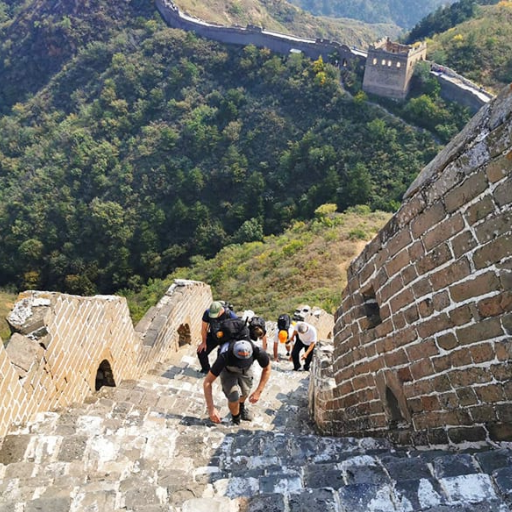
Best Time to Hike the Great Wall of China
When planning your hike, the biggest factor is not just where to go, but how much time you have. Based on my own hikes, here’s a sample day trip plan that works well for Jiankou–Mutianyu:
| Time | Activity |
|---|---|
| 7:00 AM | Depart from Beijing |
| 9:00 AM | Start hike at Jiankou trailhead |
| 12:30 PM | Reach Mutianyu, rest, take photos |
| 3:00 PM | Complete hike, descend via cable car |
| 5:00 PM | Return to Beijing |
Camping on the Great Wall: Is It Possible?
Few experiences rival sleeping beneath the stars while hiking the Great Wall of China. For hikers who want to extend their Great Wall trekking adventure, certain wild sections offer unforgettable camping opportunities. As night falls and the crowds disappear, you’re left surrounded by ancient stone, crisp mountain air, and a vast, uninterrupted sky. The sensation of lying inside a tent while centuries-old watchtowers loom quietly around you creates a surreal mix of adventure and reverence.
While official regulations prohibit camping in most restored sections to preserve the Wall’s integrity, some less monitored wild sections like Jiankou and Gubeikou have become popular spots for experienced wild campers. These areas offer the rare opportunity to watch both sunrise and sunset from the Wall itself — an unforgettable reward for those willing to handle the challenges.
However, wild camping here demands careful preparation and respect:
Jiankou: Its rugged ridgelines offer dramatic sunrise views as the first rays light up steep cliffs and endless stone ribbons. However, the terrain is unforgiving — uneven ground, limited flat surfaces, and sudden weather changes require advanced planning and high-quality gear.
Gubeikou: Known for its more moderate terrain and wider open sections, Gubeikou allows for slightly more comfortable tent placement. The views over gentle hills and ancient ruins at dawn make for an equally breathtaking, but less risky, overnight experience.
In both cases, campers must remain highly self-sufficient. There's no water supply, no services, and limited cell signal. Weather can shift dramatically overnight, with mountain winds and sudden temperature drops. Always check local conditions, pack appropriately, and strictly follow Leave No Trace principles to preserve these ancient ruins for future generations.
For travelers seeking a more regulated camping experience, Simatai offers official overnight stays with advance reservations, providing a safer way to sleep on the Wall while respecting preservation efforts.
Best Camping Spots
Camping on the Great Wall offers one of the most surreal experiences in China — imagine sleeping beneath a sky full of stars, with centuries-old stone beneath your back. While not officially permitted at all locations, several hikers find overnight shelter in less patrolled sections.
Jiankou: Wild and high above the forest canopy, this section offers epic sunrise views, though reaching the top with gear is strenuous.
Gubeikou: Easier access and relatively flat wall segments make it a great choice for setting up a peaceful camp. Watchtowers here often serve as natural shelters.
Huanghuacheng: The scenic “Water Wall” stretches by a reservoir — ideal for picturesque camping. Bring extra padding; the surface can be uneven and damp.
Simatai: The only section where official overnight stays are allowed (with advance permits), featuring dramatic lighting and more amenities.
2-Day Jiankou to Mutianyu Hiking Itinerary
For hikers who want to explore both wild and restored parts of the Wall at a relaxed pace, this overnight route is ideal.
Day 1: Settle In & Short Hike
Arrive at Xizhazi Village from Beijing
Take a warm-up hike to local highlights like “Eagle Flies Facing Upward”
Stay at a local guesthouse and enjoy a hearty mountain meal
Day 2: Jiankou to Mutianyu Trek
Begin early to catch soft morning light
Traverse rugged ridgelines toward Zhengbei Tower
Transition into restored Mutianyu, then descend via cable car or toboggan
Plan for 4 to 6 hours of hiking, depending on pace and stops
This route blends raw adventure with comfort — an ideal two-day experience near Beijing.
Camping Essentials
If you're planning to camp, prepare thoroughly:
Lightweight tent and a cold-rated sleeping bag
Compact stove, fuel, utensils, and ready-to-eat meals
Headlamp and power bank
Warm layers, gloves, and rain shell
Trash bags — follow Leave No Trace principles
GPS apps like Gaia or Maps.me (download offline maps)
Permit (if required)
Always be discreet and respectful. Avoid noisy setups, and ensure you leave no impact behind.
Trail Conditions & Safety Overview
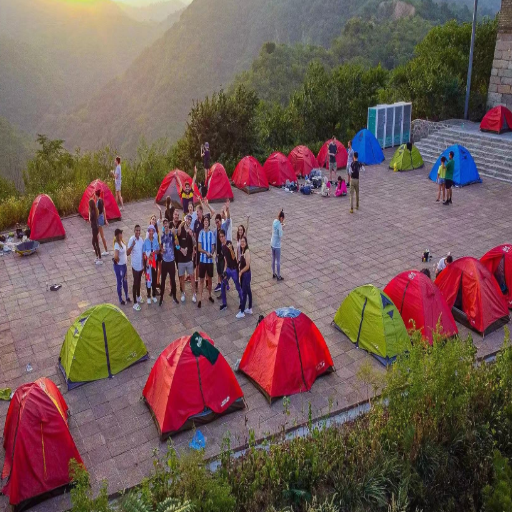
Camping along with the Great Wall of China captivates historical lovers who want to combine exploration with a deep appreciation of nature. Some of the best camping spots lie in less crowded sections that offer stunning panoramic views. Below are some of the best sections that can be visited along the Great Wall:
| Section | Surface | Difficulty |
|---|---|---|
| Jiankou | Wild, broken stone, steep ridges | Hard |
| Mutianyu | Restored, paved | Easy–Moderate |
| Jinshanling | Mixed restored & unrestored | Moderate–Hard |
| Gubeikou | Crumbling but passable | Moderate |
| Simatai | Partially restored, lit | Easy–Moderate |
Safety Tips
Common Risks and How to Avoid Them
Use trekking poles for balance on steep terrain
Always check weather — rain makes stone dangerously slick
Never hike wild sections alone
Stick to marked trails to avoid loose or unstable ground
Carry enough water and snacks for remote sections
What to Do in Case of Emergency
Share your hiking plan with someone before departure
Bring a fully charged phone and backup battery
Use offline GPS and save local emergency contacts
Be ready to turn back if conditions worsen unexpectedly
Personal Reflections: What the Great Wall Teaches You
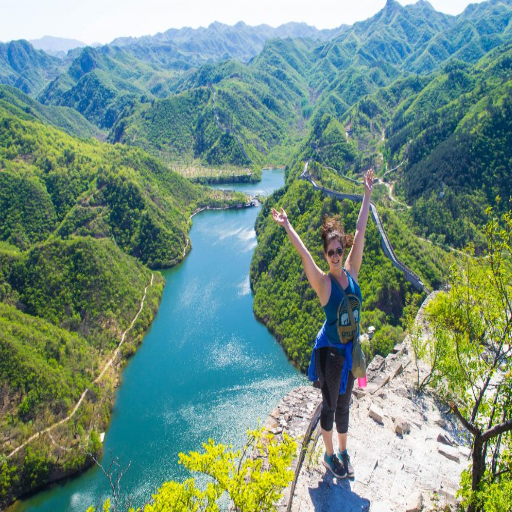
A Journey Through Solitude and Immensity
There’s a humbling moment when you stand along Jiankou’s jagged ridge during your Great Wall of China hike, gazing at the endless ribbon of stone disappearing into the horizon, gazing at the endless ribbon of stone disappearing into the horizon. The immensity of the Great Wall sinks in—not as a tourist attraction, but as an ancient monument breathing with time and human endurance. The Wall seems to pulse with quiet dignity, its fractured stones carrying the weight of forgotten soldiers, dynasties, and centuries of wind and rain.
I remember hearing nothing but the crunch of gravel underfoot and the low whistle of wind between crumbling watchtowers. The mountains stretched endlessly around me, layers of mist weaving between ridgelines like soft rivers. In that silence, I could almost feel the pulse of history beneath my boots—a stillness that makes you feel both small and deeply connected to something larger.
Lessons in Preparation and Respect for Nature
Every hike taught me something unexpected. Preparation isn’t optional — it's essential. On foggy mornings, slippery stones hide beneath invisible layers of dew, turning innocent steps into precarious slides. In dry seasons, loose gravel transforms steep descents into calculated dances of balance. Sudden gusts of wind can nearly knock you off narrow sections, and the sharp sun can drain your energy faster than you expect.
A forgotten trekking pole or underestimating hydration can quickly turn a scenic walk into a personal test of endurance and decision-making. The Wall teaches humility — nature always sets the rules, and even thousands of years of human construction can't fully tame the wildness of these mountains.
Every step reminds you that while the Great Wall was engineered for defense, today it demands respect from those who walk upon it. You don’t conquer the Wall; you negotiate with it.
Capturing Fleeting Beauty
Yet amid these challenges, the rewards are unforgettable. I’ve seen golden leaves flutter like falling coins in autumn, mountain ridges blush pink at sunrise, and heavy mist roll like silk over the hills. The early mornings at Simatai, with its towers glowing under the first light, feel almost otherworldly. The high towers of Jinshanling offer panoramic views where the Wall snakes across endless ridgelines like a living dragon.
Moments like sharing a silent snack while sitting on ancient stones, watching distant valleys breathe under morning fog, stay with me long after returning home. These aren’t simply beautiful photos to collect—they are fragments of personal memory, etched deeper each time the wind carries echoes of history through the stones.
The Great Wall doesn’t just offer breathtaking views—it teaches patience, perspective, and the beauty of fleeting stillness.
The History Beneath Your Feet
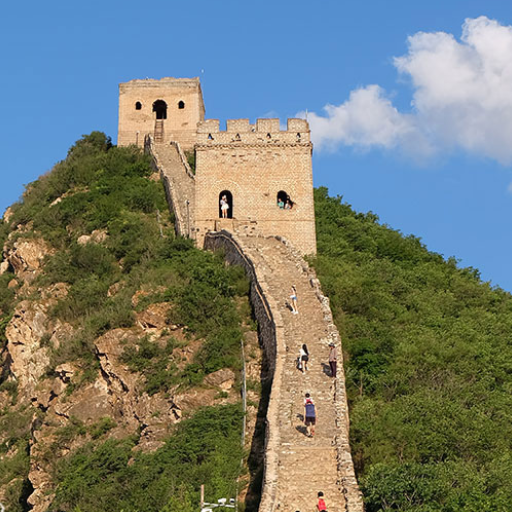
Origins in Fragmented Kingdoms
The Great Wall’s story stretches back over 2,000 years, beginning during the Warring States Period (475–221 BCE). At that time, China was divided into rival kingdoms — including Qin, Zhao, Yan, and others — each erecting its own defensive fortifications to protect territorial borders from nomadic raids and rival warlords. These early walls were primitive by today’s standards, often constructed with packed earth, stones, and wooden frames.
Though simple, these barriers served crucial military purposes — slowing invaders, channeling attacks, and protecting farmlands and critical trade routes. Many of these initial fortifications would later form the foundation of what became the unified Great Wall.
Qin Dynasty: The Birth of a Unified Wall
In 221 BCE, following his historic unification of the Chinese states, Emperor Qin Shi Huang ordered these fragmented defenses to be connected into a single, continuous defensive line. This marked the first true construction of a unified Great Wall. The scale of the project was unprecedented and involved hundreds of thousands of laborers — including conscripted soldiers, prisoners, peasants, and artisans.
The work was grueling and dangerous, often taking place across harsh deserts, mountains, and remote frontiers. Many perished due to exhaustion, starvation, and brutal working conditions, giving rise to the ancient saying: “Every stone carries a human life.”
While most of the Qin Wall was built using tamped earth, its alignment laid the groundwork for future dynasties to expand and reinforce the Wall’s presence across northern China.
Han & Northern Dynasties: Further Expansion
During the Han Dynasty (206 BCE – 220 CE), the Wall was further extended westward to secure critical sections of the Silk Road and protect vital trade routes connecting China to Central Asia and Europe. These additions played an essential role in safeguarding commerce, diplomatic missions, and military supply lines that allowed Chinese civilization to flourish across vast distances.
Later, during periods of division such as the Northern Wei and Northern Qi dynasties, further regional walls were added or repaired to strengthen frontier defenses.
Ming Dynasty: The Wall We See Today
The most iconic sections of the Great Wall that visitors explore today largely originate from the Ming Dynasty (1368–1644). After suffering repeated incursions from Mongol forces, the Ming emperors launched massive construction projects to reinforce and modernize the Wall. Unlike earlier tamped-earth versions, the Ming built with durable stone and kiln-fired brick, creating much stronger fortifications that could withstand both siege and time.
During this era, sophisticated military engineering flourished. The Wall was outfitted with watchtowers every few hundred meters, elaborate battlements, signal towers for smoke and fire communication, fortified passes, and garrison outposts. Many of today’s most famous hiking sections — including Jinshanling, Mutianyu, Simatai, and Badaling — reflect this Ming-era craftsmanship.
More Than Just Defense
While the Wall’s primary purpose was military defense, its significance stretched far beyond warfare. The Wall also served as:
A symbol of national unity, asserting the empire’s determination to defend its borders and project imperial strength.
A major checkpoint for Silk Road trade routes, regulating goods, collecting taxes, and facilitating cultural exchanges between East and West.
A psychological barrier, marking the edge of Chinese civilization and separating sedentary farming communities from nomadic tribes to the north.
Today, the Great Wall stands not only as a historic fortification but as a powerful emblem of human perseverance, architectural mastery, and cultural continuity — a bridge that connects China’s past to the present across millennia.
Essential Gear Checklist
Footwear & Clothing
Hiking Boots with Strong Grip: Essential for navigating rocky, steep, and loose terrain.
Weather-Adaptive Layers: Prepare for sudden changes—light rain jackets, insulating layers for cooler mornings, and breathable fabrics for hot afternoons.
Hydration & Nutrition
Water (2–3 liters minimum): Always bring more than you think you’ll need, especially for wild sections like Jiankou.
High-Calorie Snacks: Energy bars, trail mix, or dried fruit help maintain stamina on longer routes.
Navigation & Safety
Offline Maps & GPS: Some sections lack signal—offline apps are crucial.
Portable Charger: Keep devices operational throughout the hike.
First-Aid Kit: Include blister care, bandages, antiseptic wipes, and any personal medication.
Trekking Poles: Provide stability on steep or uneven paths.
Sun Protection
- Sunscreen, Hat & Sunglasses: UV exposure can be intense, even on cooler days.
Respect the Wall — And It Will Reward You
Preservation Practices for Responsible Hikers
As a living UNESCO World Heritage site, the Great Wall deserves respect and care:
Stick to Designated Paths: Avoid shortcutting trails or stepping on fragile structures.
Don’t Move or Collect Stones: Every piece is part of its cultural legacy.
Carry Out Trash: Leave no trace to protect the fragile mountain ecosystems.
Support Local Communities: Hire certified guides, shop local, and contribute to sustainable tourism.
Experiencing the Wall with Cultural Sensitivity
The Great Wall is more than a hiking trail. It’s a thread that binds dynasties, communities, and centuries of resilience.
Why Every Step Matters
Walking the Wall means stepping across the lives of those who built and guarded it. Many of the stones were placed by hand, in extreme conditions, by people who never saw the full scale of their creation.
How to Be a Responsible Visitor
Stay on trails — avoid fragile or unrestored areas
Don’t carve names, stack stones, or collect souvenirs
Pack out all waste, including tissues and wrappers
Support local guides and guesthouses to sustain the communities that protect this heritage
By hiking with awareness, we not only preserve the Wall but deepen our experience of it.
Frequently Asked Questions (FAQs)
Q: Can you trek the Great Wall without a guide?
Certainly, you can roam the Great Wall without a guide, especially in more popular sections like Mutianyu. But if you wish to traverse the more difficult paths, such as Jiankou to Mutianyu, having a guide in these areas greatly improves safety and allows for a more enriched experience through historical context.
Q: Is Jiankou suitable for beginners?
Jiankou is not recommended for beginners. Its rugged, steep, and unrestored trails demand solid hiking experience, physical fitness, and careful planning. Beginners are far better off starting with safer, fully restored sections like Mutianyu or moderately challenging routes such as Jinshanling, which still offer incredible views without the safety risks.
Q: Can you complete Jiankou to Mutianyu in one day?
Yes, Jiankou to Mutianyu is a popular one-day route. Depending on your pace and rest stops, it typically takes 4–5 hours to hike between these sections. Including travel time from Beijing, photo stops, and meals, you should plan for a full-day trip to comfortably complete the hike.
Q: What’s the best season to hike the Great Wall?
Spring (April–June) and autumn (September–November) are widely considered the best seasons. Spring offers blooming wildflowers and lush greenery, while autumn brings breathtaking foliage and comfortable temperatures. Summer can be uncomfortably hot and humid, while winter may bring snow and icy paths that can be risky for some hikers.
Q: Are there guided tours available for the Great Wall?
Absolutely. Many tour operators in Beijing offer guided hiking tours, especially for the more challenging sections like Jiankou, Gubeikou, and Jinshanling. Guides not only improve safety but also provide rich historical insights, assist with navigation, and handle logistics such as transportation and tickets.
Q: Do you need any permits to hike the Great Wall?
For most restored sections like Mutianyu, Jinshanling, and Badaling, you only need to purchase an entrance ticket. Some wild sections, such as parts of Jiankou or camping areas, may require permits or guide supervision depending on local regulations. Always check updated rules before your hike.
Q: Is camping allowed on the Great Wall?
Camping is generally restricted to protect the Wall's structure. However, some hikers do wild camp in remote sections like Jiankou and Gubeikou at their own risk. Simatai offers regulated overnight experiences with permits. Always prioritize safety, respect local rules, and follow Leave No Trace principles.
Q: What fitness level is needed for Great Wall hikes?
Fitness requirements depend on the section. Restored parts like Mutianyu and Badaling are suitable for almost anyone, including families and seniors. Wild sections like Jiankou or longer routes at Jinshanling demand good physical condition, balance, and endurance. Basic cardio training beforehand is helpful.
Q: Is the Great Wall safe for kids and elderly visitors?
Family-friendly sections like Mutianyu and Badaling are generally safe for children and older travelers thanks to paved paths, cable cars, and handrails. Wild or rugged areas like Jiankou and Gubeikou should be avoided for very young children or anyone with mobility concerns.
Q: What should you bring for a Great Wall day hike?
At minimum, bring sturdy hiking shoes with excellent grip, 2–3 liters of water, light snacks, sun protection (hat, sunscreen, sunglasses), layered clothing for changing weather, trekking poles for stability, a first-aid kit, a fully charged phone with offline navigation, and a portable charger.
Planning your full China journey? Explore top places to visit in Beijing and essential Shanghai experiences to make your trip unforgettable.


